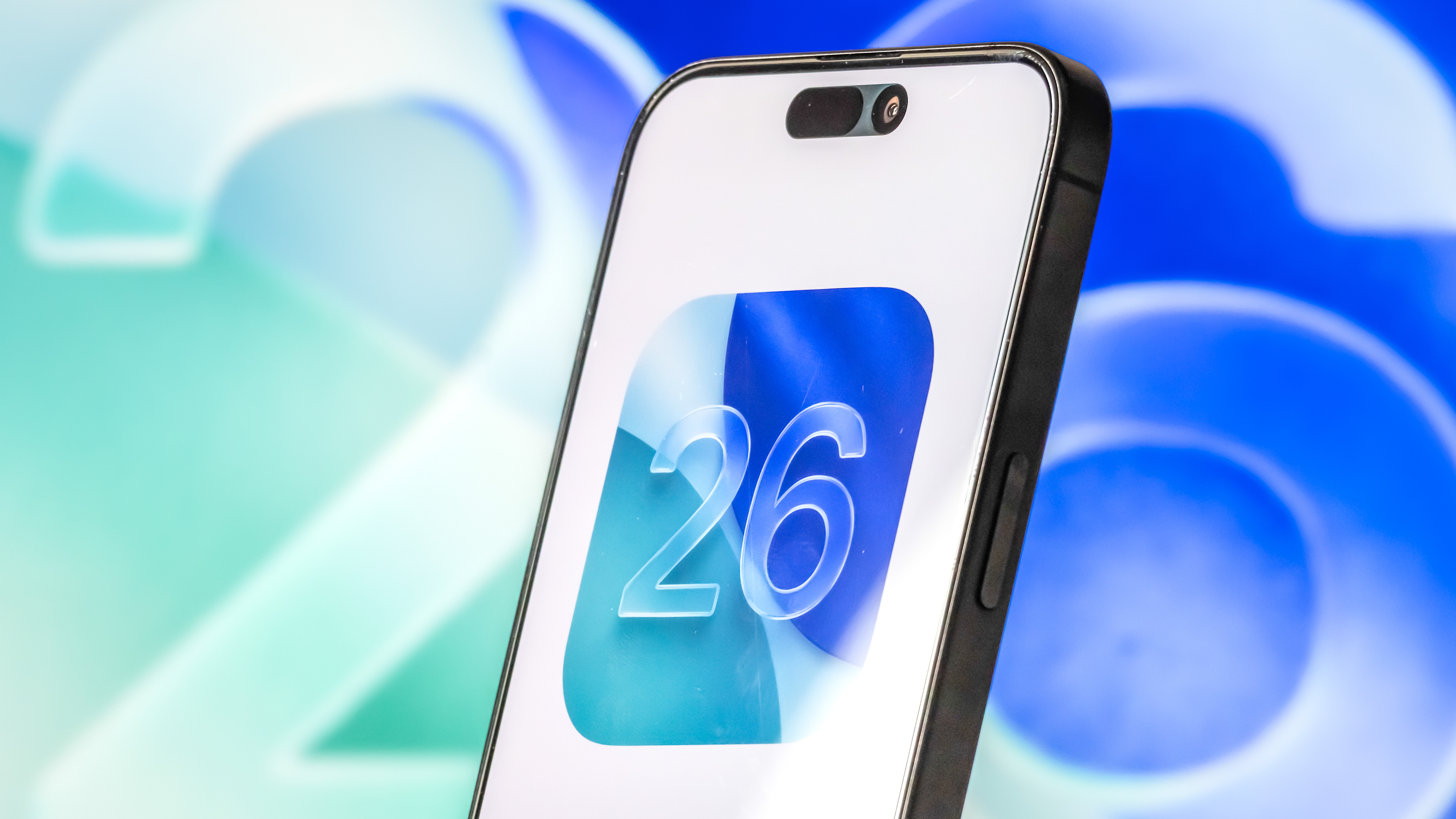iPhone 5s vs. Samsung Galaxy S5: The Winner Is…
The iPhone S5 and the Samsung Galaxy S5 are the two hottest smartphones on the planet, but which one is the best? We crown a winner.
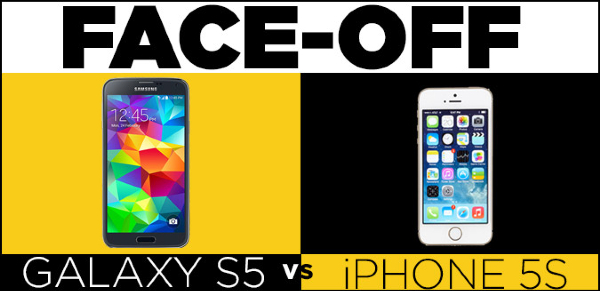
If you're in the market for a smartphone, chances are you're choosing between Apple and Samsung. In fact, the two companies own a combined two-thirds of the market. The current flagships for these brands are the iPhone 5s and the Galaxy S5. Which one should you choose?
The Galaxy S5 is less gimmicky than its predecessor but still packs unique features such as a built-in fingerprint sensor and heart rate monitor. The S5 also has a bigger display than the iPhone 5s, in a water-resistant body. Apple's device is starting to show its age, but it also sports a fingerprint reader, a first-of-its-kind 64-bit processor and a beefed up camera with larger pixels.
To help you make the right call, we compared these devices head-to-head in 11 key categories, ranging from design and camera quality to special features, performance and battery life.
Design

The design of the Galaxy S5 and iPhone 5s is a study in contrast. Samsung's phone is a fairly large hunk of plastic with a subtle, dotted pattern, and Apple's device sports a compact aluminum body with polished edges. In terms of aesthetics, this one is no contest. We'd much rather carry the iPhone 5s, which has a more premium look and feel.
The iPhone 5s is also considerably lighter and smaller (4.9 x 2.3 x .3 inches, 4 ounces) than the S5 (5.3 x 2.9 x .25 inches, 5.1 ounces), owing to the latter device's larger, 5.1-inch display. As such, the S5 is more of a stretch to use with one hand.
The S5 does have a couple of key advantages. First, its body is water resistant, which provides peace of mind for users. (Unfortunately, the S5 sports a flap on the charging port, which really gets in the way.) Second, only the Galaxy has a removable rear panel, which allows owners to replace the battery or add memory via the microSD card slot.
Winner: iPhone 5s. Apple still reigns supreme when it comes to handset design.
Get instant access to breaking news, the hottest reviews, great deals and helpful tips.
Display
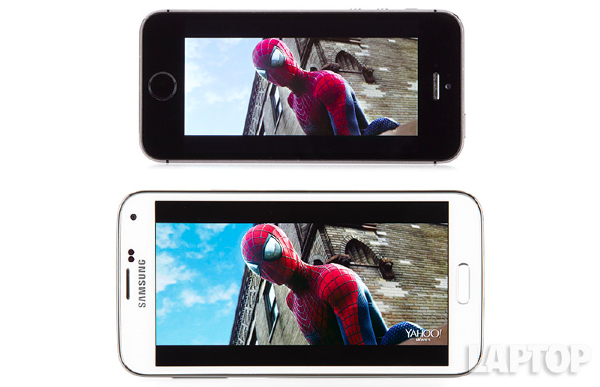
There are two key considerations when comparing the screens of the iPhone 5s and Galaxy S5: size and quality. Samsung obviously wins the size round — 5.1 inches to 4 inches — which gives users a real advantage when doing everything from viewing photos and videos to browsing the Web. The iPhone 5s looks and feels puny and dated by comparison.
When it comes to image quality, both the S5 and iPhone 5s excel in their own ways. Apple's device delivers more-accurate colors. Using our colorimeter, the iPhone registered a Delta-E score of just 0.05 (lower numbers are better). The Galaxy S5 hit 0.9 on the same test. Both of these scores are great, though. To put them in perspective, the HTC One M8 scored 4.1 on the same test, and the older S4 scored 5.7. So Samsung has definitely improved.
Where Samsung pulls ahead is color saturation, delivering 158.4 percent of the color gamut, compared to 98.4 percent for the iPhone 5s. We observed this difference when watching "The Amazing Spider-Man 2" trailer. The hero's red-and-blue costume looked more vibrant, and the sky was a richer blue, even if it was more exaggerated than what the more accurate iPhone captured. We also noticed deeper blacks on the S5's display.
The Galaxy S5 and iPhone 5s offer comparable brightness. The Samsung hit 493 lux on our light meter, compared to 500 lux for Apple's device.
Winner: Galaxy S5. The iPhone 5s has one of the best smartphone screens around, but the S5's display is bigger and bolder.
Audio
The iPhone 5s' bottom-mounted speaker blows away the Galaxy S5's back speaker in terms of volume and clarity. When we fired up Bastille's "Bad Blood," the iPhone produced much fuller sound. The vocals on the S5 sounded more distant.
When we measured the loudness of both devices, Apple's device hit 82 decibels compared to just 73 dB for the Samsung.
Winner: iPhone 5s. Apple's smartphone delivers surprising audio oomph for its size.
Interface
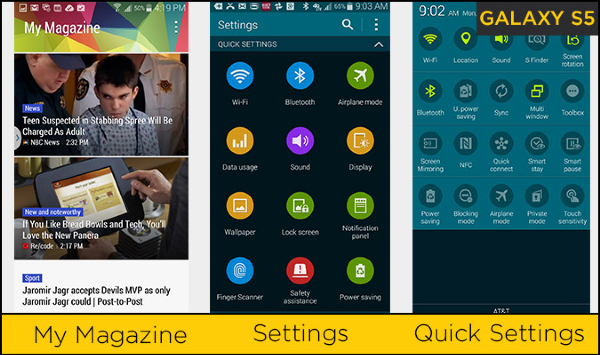
Samsung has given its TouchWiz software a fresh coat of paint for the Galaxy S5, and the result is an interface that's more attractive — yet still stuffed with options. Take the redesigned notification drawer, which houses the Quick Settings menu. We like the new circular buttons, as well as the easy access to the brightness slider, but the Galaxy has a whopping 20 shortcuts. At least you can decide the order of these settings; Apple doesn't let you do that.
The S5's camera settings menu has a dizzying grid of 23 options, but Samsung did show restraint in the camera mode menu. There are six choices, and you can download more modes.
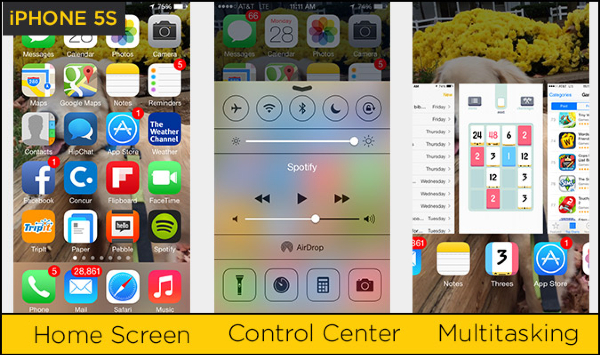
Apple's iOS 7 is more limited but feels more polished and refined. Using the iPhone 5s feels seamless, whether you're quickly toggling settings in Control Center, using Spotlight search or switching among apps. With the Galaxy S5, jumping from the My Magazine home screen to the regular home screen and the multitasking menu can feel like you're using different phones. Samsung's overall settings menu, while more colorful than before, is still more confusing to navigate than the iOS menu.
Winner: iPhone 5s. Apple's more attractive and more intuitive software trumps the S5's myriad settings and customization options.
Keyboard
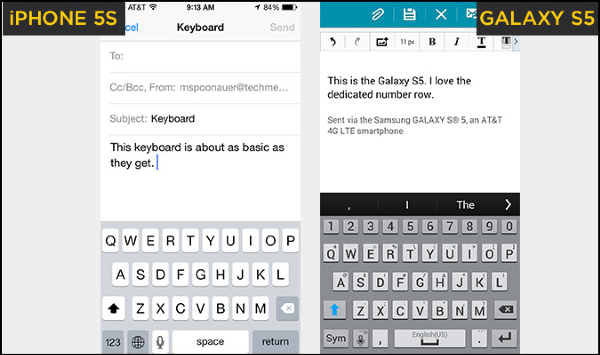
Typing on the iPhone 5s continues to be mostly accurate and fast, but there are just not enough options compared to the Galaxy. The S5's layout includes a dedicated number row — a huge time-saver — plus haptic feedback, next-word prediction and swipe typing. The larger screen makes the keys larger and easier to target. Plus, the keyboard can learn from what you type in various apps, such as Facebook and Twitter.
Winner: Galaxy S5. It's time for Apple to innovate here, or let others do it for the company by allowing third-party keyboards.
Performance
The iPhone 5s and Galaxy S5 are both armed to the teeth when it comes to specs. Apple's flagship packs a 64-bit A7 chip with 1GB of RAM, while Samsung's sports a 2.5-GHz Snapdragon 801 CPU with 2GB of RAM. So how do these devices perform?
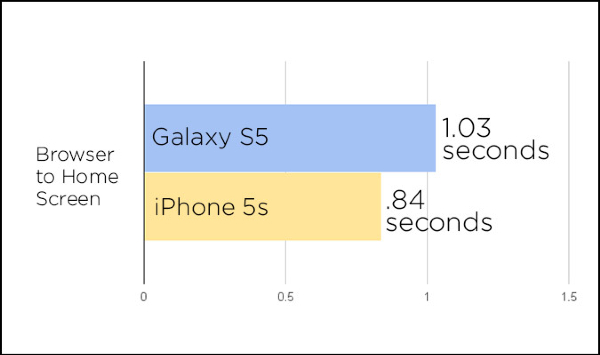
To gauge everyday responsiveness, we first exited the browser to the home screen multiple times with no other apps running. The Galaxy S5 averaged 1.03 seconds to the iPhone 5s' 0.84 seconds. Side by side, the iPhone was definitely faster.
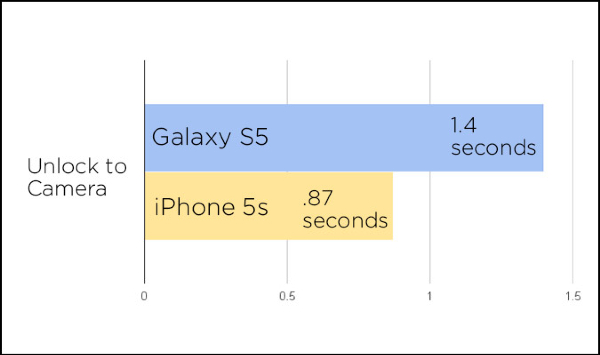
We saw similar results when unlocking the phones to the camera. The iPhone 5s was ready to fire almost instantly, averaging of 0.87 seconds. The Galaxy S5 took a leisurely 1.4 seconds.
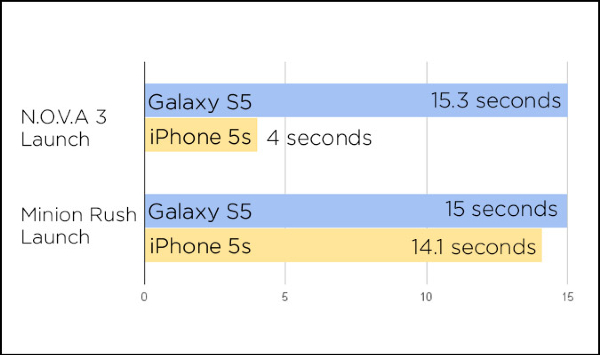
For a more demanding test, we timed how long it took each device to fire up the N.O.V.A. 3 game. The Galaxy S5 took 15.3 seconds, which is faster than most Android phones. But the iPhone 5s took only four seconds. We also used the Minion Rush game to test app-open times, and the two phones were closer. The Galaxy S5 averaged 15 seconds to the iPhone 5s' 14.1 seconds.
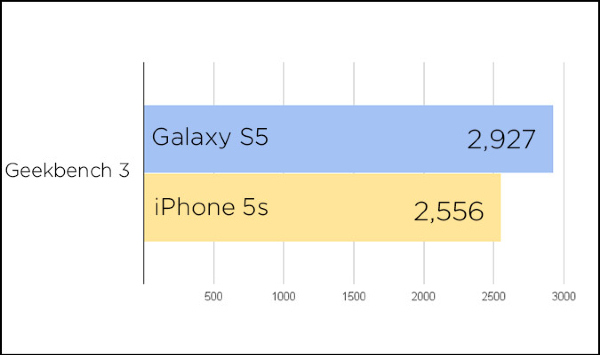
The S5 fared better in some synthetic tests. On Geekbench 3, which measures multi-core performance, the Samsung notched 2,927 to the iPhone 5s' 2,556.
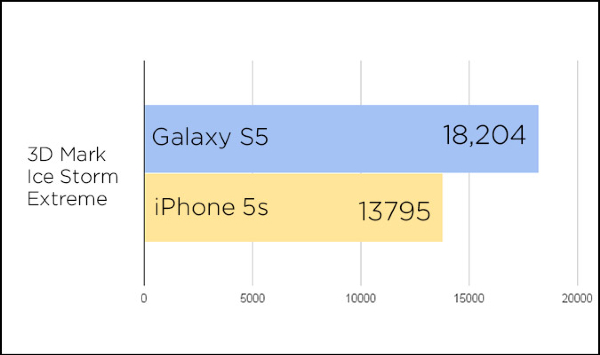
The S5 also beat the iPhone on the graphics-focused 3DMark Ice Storm Extreme by a wide margin: 18,204 to 13,795.
Winner: iPhone 5s. Apple's device is simply swifter in operation, and that's what counts most.
Camera Features
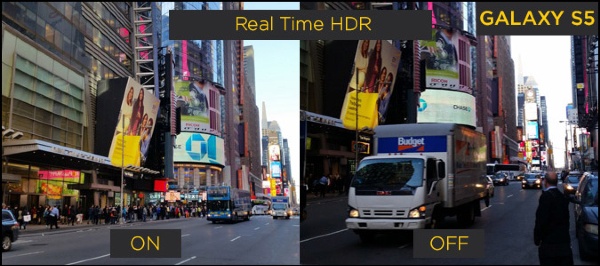
The Galaxy S5 comes with a 16-megapixel camera and some compelling new features. For example, unlike the iPhone 5s' 8-MP shooter, Samsung's real-time HDR function lets you preview the results before you shoot. Apple's HDR mode takes two shots and combines them for the best image.
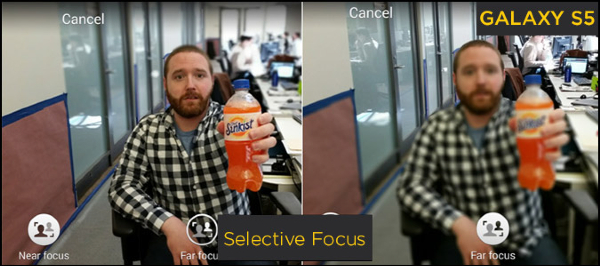
The S5 also lets you focus on the foreground or the background of your image after you take the shot. Last but not least, a new Shot & More mode lets you take a series of photos and then apply a number of effects and additional modes, such as Eraser (for getting rid of photobombers) and Best Face (for choosing the best mugs in a photo).
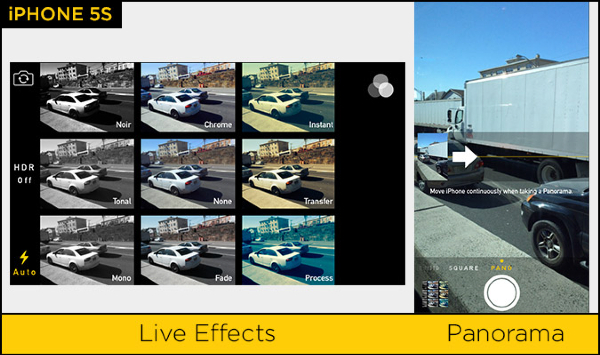
The iPhone 5s keeps things very simple for modes and settings. The most notable options are the fun live effects (like Chrome and Instant), Panorama and Slo-Mo video. The S5 offers a ton of settings and lets users download more modes.
Winner: Galaxy S5. There are plenty of ways to get creative and have fun on the Samsung.
Camera Quality
Samsung has definitely upped its camera game. With the exception of shots taken in low light without flash, the S5 offered comparable if not better image quality than the iPhone 5s. Here are some sample shots and our comments, incorporating feedback from our photo editor.
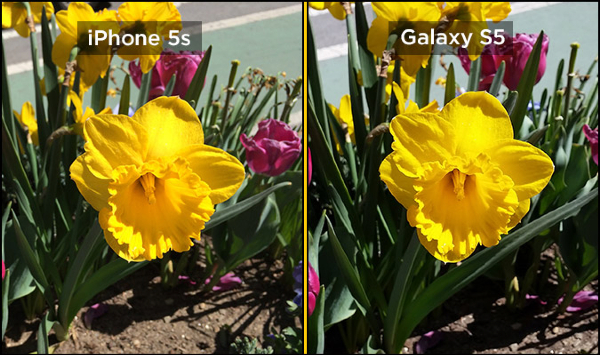
We first took a close-up of a yellow flower. Both the iPhone 5s and Galaxy S5 delivered very good results with impressive depth of field. The color in the iPhone shot is warmer, but otherwise we wouldn't say one shot looks better.
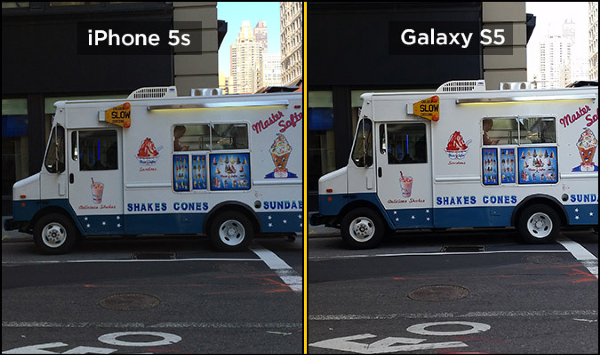
The Galaxy S5 wins this round because the main subject looks brighter and clearer. However, the sky is bluer in the iPhone 5s photo.
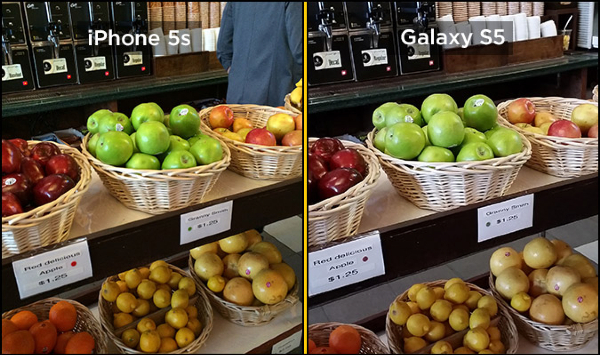
The iPhone's color is richer and more saturated in this shot. The overall exposure on the iPhone is a little darker, though. There is better detail in the cup lids of the iPhone photo. Both images are soft at full size, but acceptable.
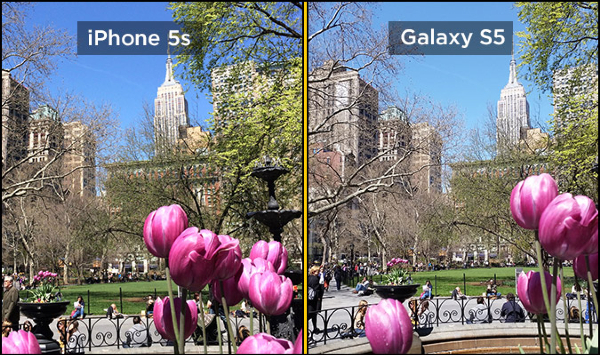
The iPhone 5s exposes a little dark to keep the highlights from going white. The sky is a little grainy vs. the S5. The color on both is acceptable. The iPhone is a little softer overall, but the flowers are not as soft as in the S5.
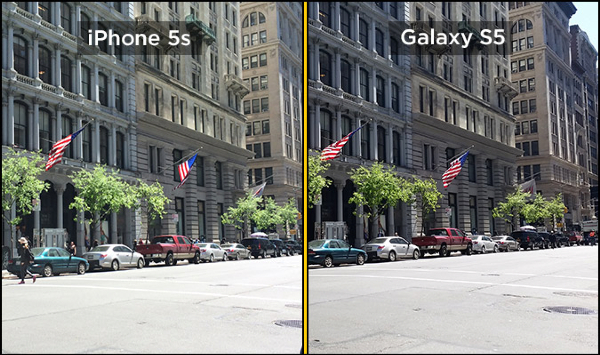
The iPhone looks to have a slight haze over the image, making it appear duller than the S5. We like the brightness of the iPhone image, but prefer the contrast of the S5 image. The color also looks a little off on the iPhone.
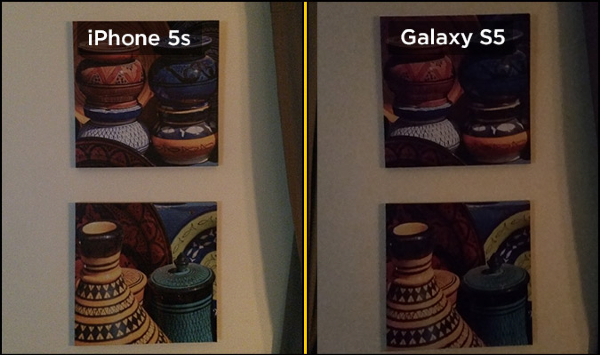
The iPhone 5s wins hands-down here. The S5's image is grainy and darker.
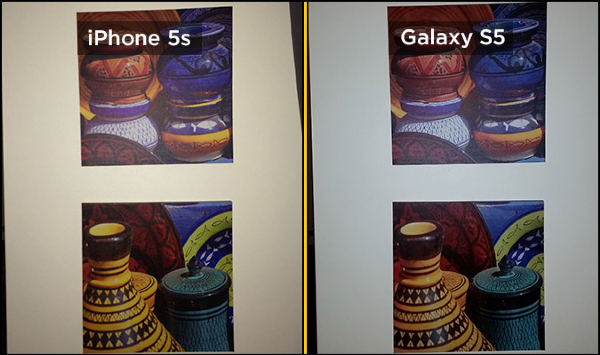
Apple's device also produced a cleaner white with the flash and a better-exposed image.
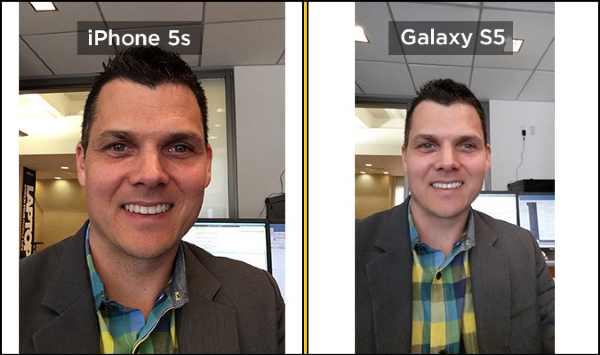
The Galaxy S5 is the clear winner with its 2.1-MP front camera. The iPhone 5s' 1.2-MP shooter produced a hazier shot with duller colors.
Winner: Draw. The iPhone 5s and S5 offer comparable image quality outdoors. The S5 has a better front camera, and the 5s performs better in low light (especially without flash).
Special Features
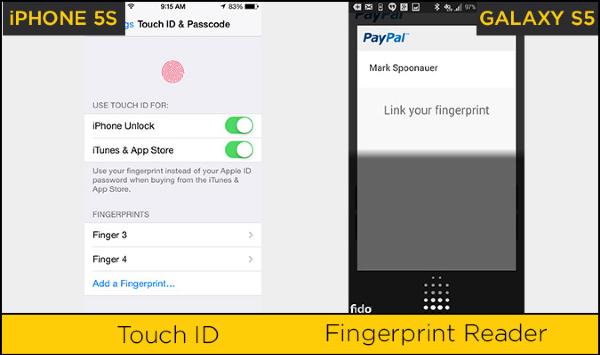
The iPhone 5s' biggest feature is its Touch ID sensor, which lets you unlock the phone and make iTunes purchases using your finger. However, you can't do anything else with this feature. The Galaxy S5's fingerprint reader adds the ability to pay for items via PayPal, but its sensor isn't as consistently accurate. We encountered more false negatives than on the iPhone 5s.
Apple's device also packs an M7 motion coprocessor, which is designed for use with such fitness apps as Fitbit. Samsung once again goes further by including a built-in heart rate monitor with its S5 as well as its own S Health app. You can use this app to track your diet and receive coaching while you exercise. (Apple is apparently working on a health app of its own, but that app won't be released until iOS 8 debuts.)
We're not surprised that Samsung hasn't said much about its S Voice assistant lately, because S Voice hasn't gotten much smarter. When we asked our S5 where the nearest Mexican restaurant was, then asked, "What about steakhouses?" it responded that it didn't know what we meant. Apple's Siri, on the other hand, knew we were still talking about restaurants and displayed relevant local results.
Siri also offers better Twitter integration. For instance, when we asked, "What is Jimmy Fallon saying on Twitter?" we got a list of the comedian's latest Tweets. S Voice instead performed a Google search.
The S5 boasts a lot of other special features that the iPhone 5s doesn't have. This includes Multi Window, which allows you to view two open applications side by side, and even drag and drop content from one window into another. There's also Ultra Power Saving Mode, which lets you last a lot longer on a charge by disabling unnecessary features and turning the screen black-and-white. Add in a built-in TV remote, and it's easy to see why Apple trails in this category.
Winner: Galaxy S5. The S5 just has a lot more to offer.
Battery Life
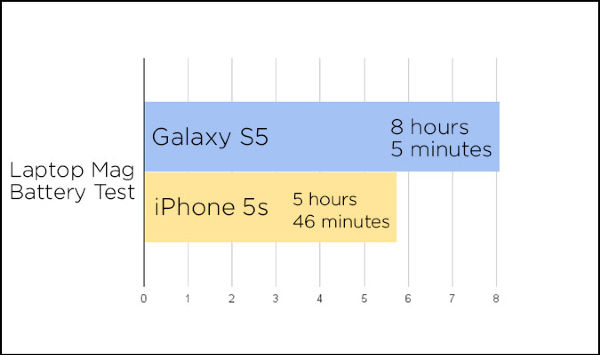
The Galaxy S5 packs a bigger battery than the S4 (2,800 mAh vs. 2,600 mAh) — and it shows. On the Laptop Mag Battery test, which involves continuous Web surfing over 4G LTE on 40 percent brightness, the Samsung lasted an impressive 8 hours and 5 minutes. The iPhone 5s lasted only 5 hours and 46 minutes. That's more than a two-hour difference in runtime.
Winner: Galaxy S5. Considerably longer battery life makes Samsung the easy pick in this round.
Apps

The Google Play store now has pretty much every major app you can think of, but Apple's App Store still tends to get the hottest apps and games first. For example, the popular IFTT (If This, Then That) app just launched on Android, nine months after the iOS version debuted. TweetBot, Day One, Dark Sky and LinkedIn CardMunch are just some of the compelling apps still missing from the Google Play store.
Apple also had a lead in game quality and selection. "Hearthstone" and "Infinity Blade III" are two good examples.
The S5 does pack some uniquely compelling apps from Samsung, including Smart Remote for controlling your TV and S Health for tracking your exercise and diet. However, only the S5 suffers from carrier bloatware. For instance, the AT&T version comes with more than a dozen apps from the carrier, most of which are useless.
Winner: iPhone 5s. Developers still favor iOS, and the result is a more robust library of high-quality apps and games.
Overall Winner: Samsung Galaxy S5
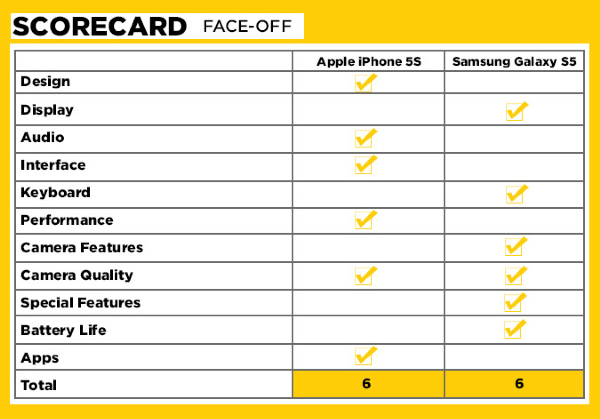
According to our scorecard, the iPhone 5s and Galaxy S5 tie in this smartphone face-off, each earning 6 points in 11 rounds of battle. But a draw would be boring. We have to declare a winner, and it comes down to which strengths matter most.
The iPhone 5s boasts a better design, louder and clearer audio, and a cleaner and more intuitive interface. More importantly, Apple's device is faster in everyday use. The iPhone also sports an excellent camera, beating the Galaxy S5 indoors (especially in low light). Last but not least, iPhone 5s buyers will be able to enjoy the latest and greatest apps first.
Samsung's Galaxy S5 is like an all-you-can-eat buffet. The user experience isn't as curated as on the iPhone, but you can go hog wild with options, features and customizations. We also appreciate the Galaxy's water-resistant shell.
The two reasons the S5 wins this very closely fought match are its larger, richer display and longer battery life. Everything simply looks better on the larger, 5.1-inch canvas, and you can't ignore a two-hour-plus advantage in runtime.
Follow Mark Spoonauer at @mspoonauer. Follow Tom's Guide at @tomsguide, on Facebook and on Google+.
Mark Spoonauer is the global editor in chief of Tom's Guide and has covered technology for over 20 years. In addition to overseeing the direction of Tom's Guide, Mark specializes in covering all things mobile, having reviewed dozens of smartphones and other gadgets. He has spoken at key industry events and appears regularly on TV to discuss the latest trends, including Cheddar, Fox Business and other outlets. Mark was previously editor in chief of Laptop Mag, and his work has appeared in Wired, Popular Science and Inc. Follow him on Twitter at @mspoonauer.

